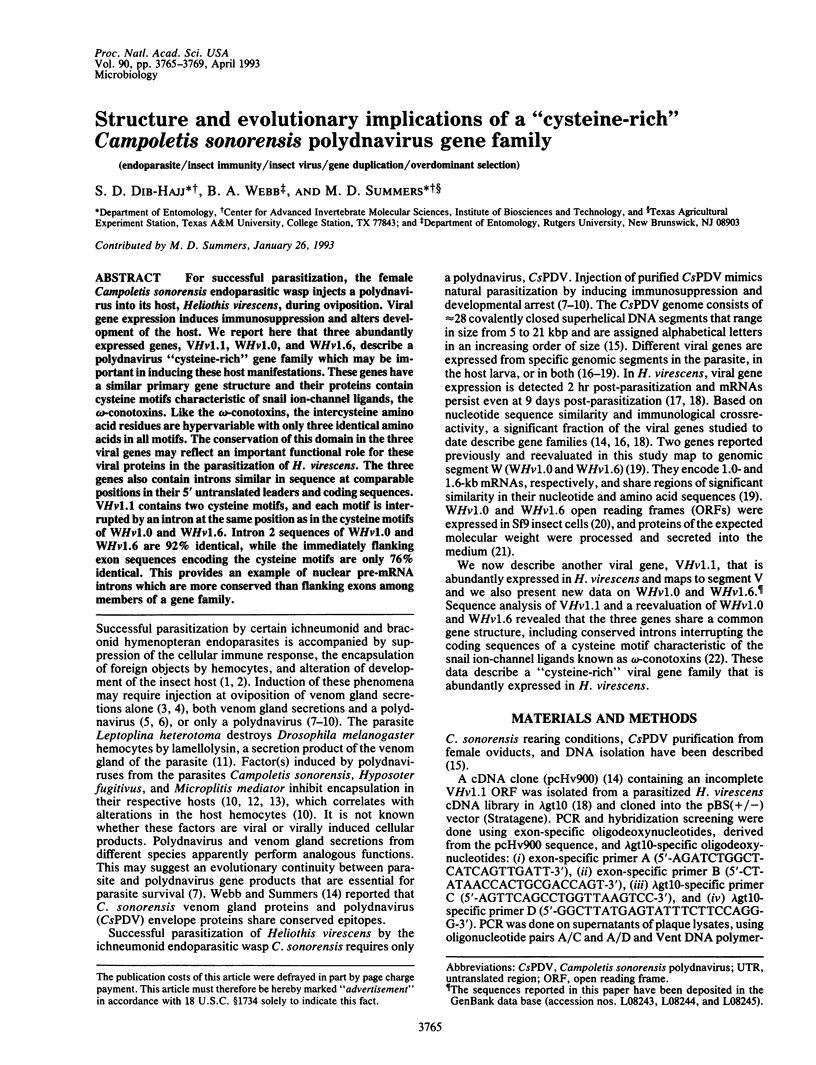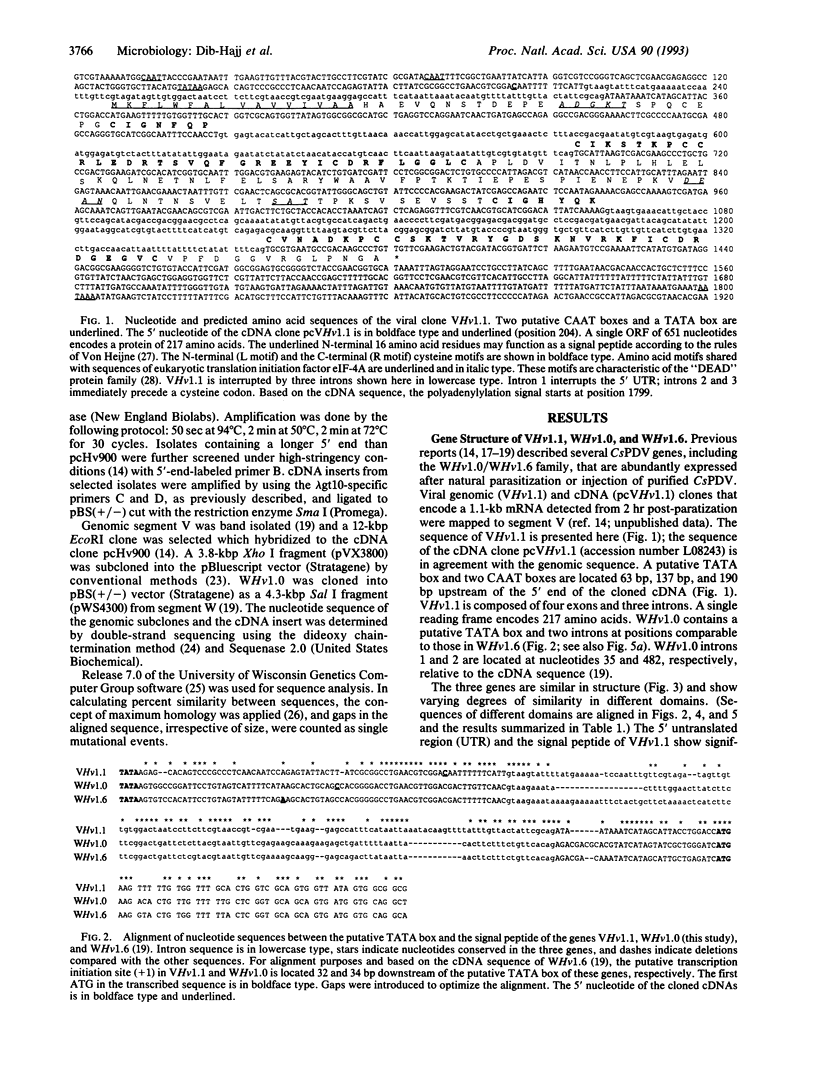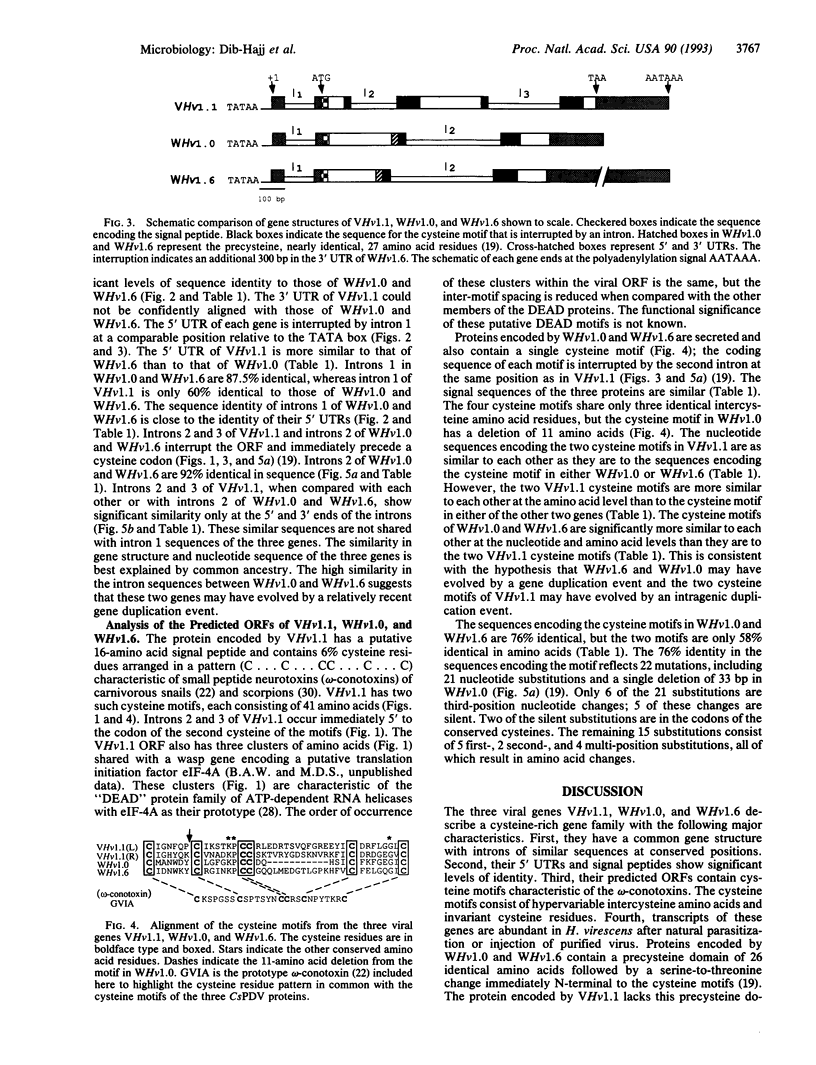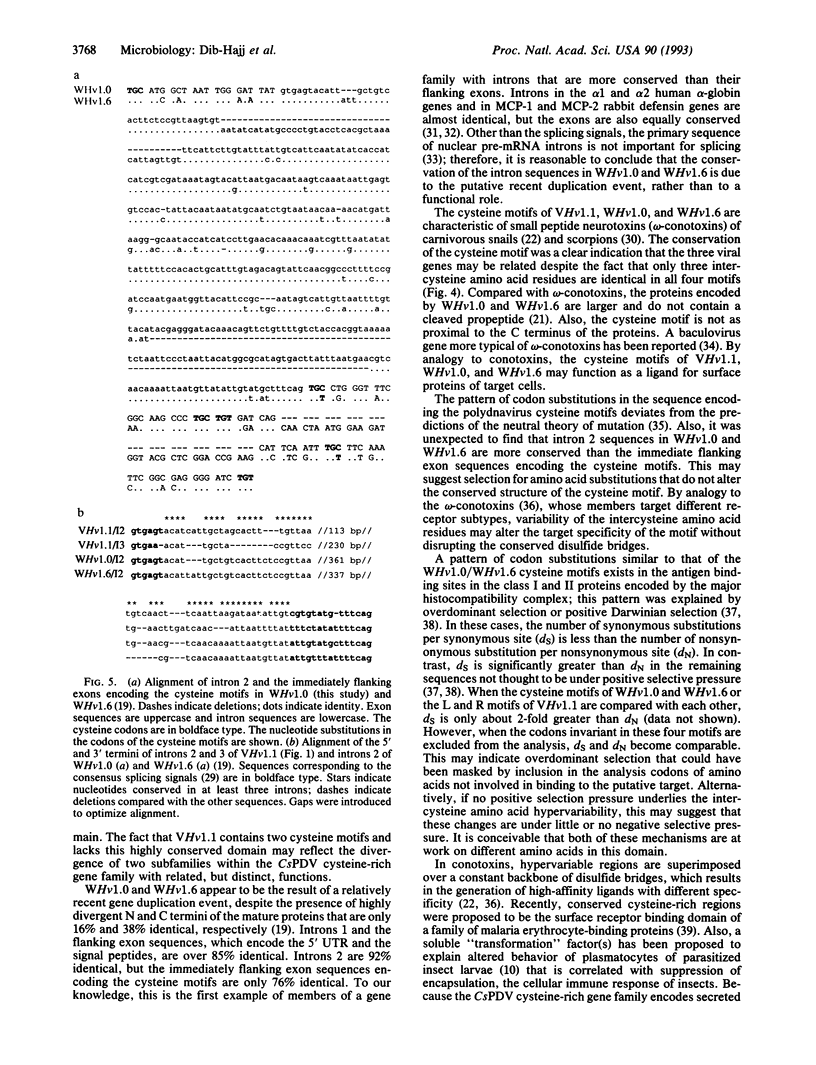Abstract
For successful parasitization, the female Campoletis sonorensis endoparasitic wasp injects a polydnavirus into its host, Heliothis virescens, during oviposition. Viral gene expression induces immunosuppression and alters development of the host. We report here that three abundantly expressed genes, VHv1.1, WHv1.0, and WHv1.6, describes a polydnavirus "cysteine-rich" gene family which may be important in inducing these host manifestations. These genes have a similar primary gene structure and their proteins contain cysteine motifs characteristic of snail ion-channel ligands, the omega-conotoxins. Like the omega-conotoxins, the intercysteine amino acid residues are hypervariable with only three identical amino acids in all motifs. The conservation of this domain in the three viral genes may reflect an important functional role for these viral proteins in the parasitization of H. virescens. The three genes also contain introns similar in sequence at comparable positions in their 5' untranslated leaders and coding sequences. VHv1.1 contains two cysteine motifs, and each motif is interrupted by an intron at the same position as in the cysteine motifs of WHv1.0 and WHv1.6. Intron 2 sequences of WHv1.0 and WHv1.6 are 92% identical, while the immediately flanking exon sequences encoding the cysteine motifs are only 76% identical. This provides an example of nuclear pre-mRNA introns which are more conserved than flanking exons among members of a gene family.
Full text
PDF




Selected References
These references are in PubMed. This may not be the complete list of references from this article.
- Adams J. H., Sim B. K., Dolan S. A., Fang X., Kaslow D. C., Miller L. H. A family of erythrocyte binding proteins of malaria parasites. Proc Natl Acad Sci U S A. 1992 Aug 1;89(15):7085–7089. doi: 10.1073/pnas.89.15.7085. [DOI] [PMC free article] [PubMed] [Google Scholar]
- Blissard G. W., Smith O. P., Summers M. D. Two related viral genes are located on a single superhelical DNA segment of the multipartite Campoletis sonorensis virus genome. Virology. 1987 Sep;160(1):120–134. doi: 10.1016/0042-6822(87)90052-3. [DOI] [PubMed] [Google Scholar]
- Blissard G. W., Theilmann D. A., Summers M. D. Segment W of Campoletis sonorensis virus: expression, gene products, and organization. Virology. 1989 Mar;169(1):78–89. doi: 10.1016/0042-6822(89)90043-3. [DOI] [PubMed] [Google Scholar]
- Czelusniak J., Goodman M., Moncrief N. D., Kehoe S. M. Maximum parsimony approach to construction of evolutionary trees from aligned homologous sequences. Methods Enzymol. 1990;183:601–615. doi: 10.1016/0076-6879(90)83039-c. [DOI] [PubMed] [Google Scholar]
- Devereux J., Haeberli P., Smithies O. A comprehensive set of sequence analysis programs for the VAX. Nucleic Acids Res. 1984 Jan 11;12(1 Pt 1):387–395. doi: 10.1093/nar/12.1part1.387. [DOI] [PMC free article] [PubMed] [Google Scholar]
- Edson K. M., Vinson S. B., Stoltz D. B., Summers M. D. Virus in a parasitoid wasp: suppression of the cellular immune response in the parasitoid's host. Science. 1981 Feb 6;211(4482):582–583. doi: 10.1126/science.7455695. [DOI] [PubMed] [Google Scholar]
- Eldridge R., Li Y., Miller L. K. Characterization of a baculovirus gene encoding a small conotoxinlike polypeptide. J Virol. 1992 Nov;66(11):6563–6571. doi: 10.1128/jvi.66.11.6563-6571.1992. [DOI] [PMC free article] [PubMed] [Google Scholar]
- Fleming J. A., Blissard G. W., Summers M. D., Vinson S. B. Expression of Campoletis sonorensis Virus in the Parasitized Host, Heliothis virescens. J Virol. 1983 Oct;48(1):74–78. doi: 10.1128/jvi.48.1.74-78.1983. [DOI] [PMC free article] [PubMed] [Google Scholar]
- Fontecilla-Camps J. C. Three-dimensional model of the insect-directed scorpion toxin from Androctonus australis Hector and its implication for the evolution of scorpion toxins in general. J Mol Evol. 1989 Jul;29(1):63–67. doi: 10.1007/BF02106182. [DOI] [PubMed] [Google Scholar]
- Ganz T., Rayner J. R., Valore E. V., Tumolo A., Talmadge K., Fuller F. The structure of the rabbit macrophage defensin genes and their organ-specific expression. J Immunol. 1989 Aug 15;143(4):1358–1365. [PubMed] [Google Scholar]
- Hughes A. L., Nei M. Nucleotide substitution at major histocompatibility complex class II loci: evidence for overdominant selection. Proc Natl Acad Sci U S A. 1989 Feb;86(3):958–962. doi: 10.1073/pnas.86.3.958. [DOI] [PMC free article] [PubMed] [Google Scholar]
- Hughes A. L., Nei M. Pattern of nucleotide substitution at major histocompatibility complex class I loci reveals overdominant selection. Nature. 1988 Sep 8;335(6186):167–170. doi: 10.1038/335167a0. [DOI] [PubMed] [Google Scholar]
- Kitano Y., Okada N., Adachi J. TPA-induced alteration of actin organization in cultured human keratinocytes. Exp Cell Res. 1986 Dec;167(2):369–375. doi: 10.1016/0014-4827(86)90177-1. [DOI] [PubMed] [Google Scholar]
- Krell P. J., Summers M. D., Vinson S. B. Virus with a Multipartite Superhelical DNA Genome from the Ichneumonid Parasitoid Campoletis sonorensis. J Virol. 1982 Sep;43(3):859–870. doi: 10.1128/jvi.43.3.859-870.1982. [DOI] [PMC free article] [PubMed] [Google Scholar]
- Liebhaber S. A., Goossens M., Kan Y. W. Homology and concerted evolution at the alpha 1 and alpha 2 loci of human alpha-globin. Nature. 1981 Mar 5;290(5801):26–29. doi: 10.1038/290026a0. [DOI] [PubMed] [Google Scholar]
- Olivera B. M., Rivier J., Clark C., Ramilo C. A., Corpuz G. P., Abogadie F. C., Mena E. E., Woodward S. R., Hillyard D. R., Cruz L. J. Diversity of Conus neuropeptides. Science. 1990 Jul 20;249(4966):257–263. doi: 10.1126/science.2165278. [DOI] [PubMed] [Google Scholar]
- Padgett R. A., Grabowski P. J., Konarska M. M., Seiler S., Sharp P. A. Splicing of messenger RNA precursors. Annu Rev Biochem. 1986;55:1119–1150. doi: 10.1146/annurev.bi.55.070186.005351. [DOI] [PubMed] [Google Scholar]
- Rizki R. M., Rizki T. M. Effects of lamellolysin from a parasitoid wasp on Drosophila blood cells in vitro. J Exp Zool. 1991 Feb;257(2):236–244. doi: 10.1002/jez.1402570214. [DOI] [PubMed] [Google Scholar]
- Sanger F., Nicklen S., Coulson A. R. DNA sequencing with chain-terminating inhibitors. Proc Natl Acad Sci U S A. 1977 Dec;74(12):5463–5467. doi: 10.1073/pnas.74.12.5463. [DOI] [PMC free article] [PubMed] [Google Scholar]
- Schmid S. R., Linder P. D-E-A-D protein family of putative RNA helicases. Mol Microbiol. 1992 Feb;6(3):283–291. doi: 10.1111/j.1365-2958.1992.tb01470.x. [DOI] [PubMed] [Google Scholar]
- Senapathy P., Shapiro M. B., Harris N. L. Splice junctions, branch point sites, and exons: sequence statistics, identification, and applications to genome project. Methods Enzymol. 1990;183:252–278. doi: 10.1016/0076-6879(90)83018-5. [DOI] [PubMed] [Google Scholar]
- Theilmann D. A., Summers M. D. Identification and comparison of Campoletis sonorensis virus transcripts expressed from four genomic segments in the insect hosts Campoletis sonorensis and Heliothis virescens. Virology. 1988 Dec;167(2):329–341. [PubMed] [Google Scholar]
- Theilmann D. A., Summers M. D. Molecular analysis of Campoletis sonorensis virus DNA in the lepidopteran host Heliothis virescens. J Gen Virol. 1986 Sep;67(Pt 9):1961–1969. doi: 10.1099/0022-1317-67-9-1961. [DOI] [PubMed] [Google Scholar]
- Webb B. A., Summers M. D. Venom and viral expression products of the endoparasitic wasp Campoletis sonorensis share epitopes and related sequences. Proc Natl Acad Sci U S A. 1990 Jul;87(13):4961–4965. doi: 10.1073/pnas.87.13.4961. [DOI] [PMC free article] [PubMed] [Google Scholar]
- Woodward S. R., Cruz L. J., Olivera B. M., Hillyard D. R. Constant and hypervariable regions in conotoxin propeptides. EMBO J. 1990 Apr;9(4):1015–1020. doi: 10.1002/j.1460-2075.1990.tb08204.x. [DOI] [PMC free article] [PubMed] [Google Scholar]
- von Heijne G. A new method for predicting signal sequence cleavage sites. Nucleic Acids Res. 1986 Jun 11;14(11):4683–4690. doi: 10.1093/nar/14.11.4683. [DOI] [PMC free article] [PubMed] [Google Scholar]


